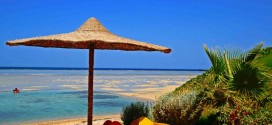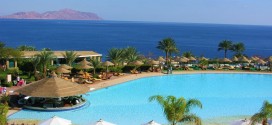History of Sinai

There are moments in Sinai when one feels the history of the entire world written in its stones. Indeed, the land here is a monument of the history and development of life on earth, from the fossilized reef animals of Ras Mohamed to the copper mines of El Maghara, dating back to the Bronze Age. Thousands of years ago visitors recorded their passage on the Rock of Inscriptions near Dahab and at Serabit El-Khadem, near ancient mining sites, archaeologists have discovered carvings of the very earliest emergence of our alphabet.
The three most important religions Christianity, Islam and Judaism acknowledge Sinai as the Holy Land, where prophets, saints, pilgrims, and warriors lived. Sinai is most familiar to many as the great and terrible wilderness “through which the Israeli wandered for forty years”. However, it was also the path by which Amr swept down into Egypt in 640 AD, bringing Islam in his wake.
Many of the historic conquerors have passed through the Sinai peninsular as well. Alexander the Great crossed it with his army, so did Ramses II, Napoleon Bonaparte, and (in the opposite direction) Salah El-Din. The Arab-Israeli conflict of this century raged across the Sinai as well, still evident in the ghostly wreckage that marks certain parts of the Suez coast.

Nowadays, for the first time, the history of Sinai is written by the people themselves, by the monuments and artifacts, and by its natural beauty. The brilliant coral reefs, the striking mountains and wild desert, and, above all, the enormous cultural heritage holds the future once again, though in a very different way, the history of Sinai is written in the land itself.
Sinai – Places of Interest
El-Tor (Tur Sinai)
A fast developing clean and modern city and the capital of south Sinai Governorate with a number of different tourist accommodations and facilities.
El Arish
Shady palm-lined beaches, Mediterranean waves and the glowing colours of Bedouin handicrafts mark this northern sea resort town. Good restaurants, hotels and several resort complexes guarantee visitors a pleasant time. Worth a visit is the permanent exhibition of Bedouin art and tradition near the Zoological Garden on the outskirts of the town as well as the Pharaonic fortress in El-Arish, rebuilt by the Ottomans in 1560, resorted by Napoleon Bonaparte’s troops in 1799, and destroyed by British bombers during World War I.
The Sinai Heritage Museum in El-Arish
The Sinai Heritage Museum is located on the eastern outskirts of El-Arish and provides information about rural life in Sinai. The museum displays mostly Bedouin products including handicrafts, tools, clothing and medicines, and is open from Saturday through Thursday from 9.30am until 2pm.
Blue Desert
When Belgian artist Jean Berame came to the Sinai in 1980 he armed himself with ten tons of UN-blue paint, went to the rocky desert and covered enormous brown boulders in blue – the color of peace. The result is an extraordinary surrealistic impression between St Catherine and Dahab. The mighty paint covered stones (some more than 30m high) contrast vividly with the red, brown and yellow of the desert and the deep blue skies. The artist has masterfully used the landscape of Sinai – once a battleground in the 1967 war between Egypt and Israel – as his canvas to honour the realization of peace between the two nations.
Colored Canyon
Millions of years ago, when the Sinai was covered by sea waters, nowhere else did the ancient ocean leave a more brilliant legacy than that in the Colored Canyon near Nuweiba. The walls of the Canyon, reaching up to sixteen stories, are the most colourful and intriguing rock formations in all of Sinai resulting from water erosion on sandstone and limestone. In some places the deep rock coloration gives the canyon walls a prismic and metallic sheen; in others, the stone is so smooth that it appears soft and billowy.
Firan Oasis
The great Wadi Firan, Sinai’s largest Wadi is one of the most important archaeological stretches of the peninsular. It was here, according to legend, that Moses struck a rock with his staff, bringing forth a spring for his people to drink. Firan is also the site of Rafadim, the oasis where the Hebrews camped and fought the Amelecites. For the pilgrims and believers who have come to this Wadi for centuries, a journey through Firan is to pass through an entire chapter of the Old Testament, Exodus 17.
Given such prominence in the Old Testament, it is no surprise that Firan is littered with the ruins of dozens of ancient churches; some dating back to the 4th century AD, when Firan began to develop into a major religious center for monks and pilgrims, many on their way to Mt. Sinai and St Catherine Monastery further east. The Wadi’s main religious sites are the rock from which Moses drew water, on the western entrance to the Oasis, and Mount Tahoun, which Moses supposedly used as an observation point during the battle with the Amelecites. The mountain is crowned by an ancient cross and by the ruins of a small church dating back to the 4th century.
The Oasis of Firan is the largest oasis in all of Sinai. The heart of the Oasis is spectacular and a luxuriant sprawl of palms stretching over four kilometers, the reason why Firan is called the “Pearl of Sinai”. Along the edges of the Oasis and the Wadi are the dramatic, often sheer cliffs of the Wadi wall contributing to the valley’s secretive and paradisical atmosphere.
Serabit El-Khadem
According to archaeologists mine workers were the earliest settlers in the Sinai. Drawn by the region’s abundant copper and turquoise deposits these workers arrived about 8,000 years ago and worked their way from one deposit to the next southward. By 3500 BC, the great turquoise veins of Serabit El-Khadem had been discovered.
At the same time the Kingdom of Egypt was united under its first pharaohs. These great rulers soon turned their eyes eastward. Around 3000 BC, the Egyptians had become masters of the Sinai mines and set up a large and systematic operation site at Serabit El-Khadem. For the next two thousand years turquoise stones were mined from Serabit El-Khadem, carried down the Wadi Matalla to the garrisoned port of El-Markha, and set aboard boats bound for Egypt. For the Egyptians, the brilliant blue-green stone served myriad purposes: scarabs were carved from it, and the bright mineral enamels of powdered turquoise were used to colour everything from fine statuettes to bricks.
To mine the turquoise, the Egyptians would dig large galleries into the mountains, carving at the entrance to each mine a personal image of the reigning pharaoh – a symbol of the authority of the Egyptian state over the mine and its yield. Although many of the region’s pharaonic reliefs were destroyed by the British attempt to re-open the mines in the mid-nineteenth century, the excellent bas-relief of Pharaoh Sekhemkhet on the east side of Gebel Maghara survived. Also, at Serabit El-Khadem are the ruins of a temple dedicated to Hathor, containing a large number of bas-reliefs and carved steles.
Taba
At the northern outer edge of the Gulf of Aqaba lies the small town of Taba, a picturesque beach town that in ancient times was a stopover on the caravan route to the fort of Aqaba. In modern times, it is best known as the last piece of land that was returned to Egypt following Israel’s occupation of Sinai.
Taba is situated right at the Egyptian/Israeli border, which can be crossed on foot. The town is a perfect starting point to visit The Island of The Pharaoh and/or the Israeli city of Eilat.
The Island of the Pharoah
South of Taba, at the very top of the Gulf of Aqaba and just a few hundred meters from the coast, lies Pharaoh’s Island. Surmounted by the imposing crenellated bulk of the resorted citadel of Salah El-Din, Pharoah’s Island is one of the most picturesque spots on the entire gulf. While the resorted fortifications have firmly imposed a medieval character upon the island, the history of Geziret Faroun is actually one of exceptional complexity and interest.
 Sakura Travel World Group
Sakura Travel World Group








